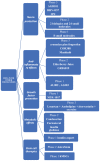Current and Future Treatments in Alzheimer Disease: An Update
- PMID: 32165850
- PMCID: PMC7050025
- DOI: 10.1177/1179573520907397
Current and Future Treatments in Alzheimer Disease: An Update
Abstract
Disease-modifying treatment strategies for Alzheimer disease (AD) are still under extensive research. Nowadays, only symptomatic treatments exist for this disease, all trying to counterbalance the neurotransmitter disturbance: 3 cholinesterase inhibitors and memantine. To block the progression of the disease, therapeutic agents are supposed to interfere with the pathogenic steps responsible for the clinical symptoms, classically including the deposition of extracellular amyloid β plaques and intracellular neurofibrillary tangle formation. Other underlying mechanisms are targeted by neuroprotective, anti-inflammatory, growth factor promotive, metabolic efficacious agents and stem cell therapies. Recent therapies have integrated multiple new features such as novel biomarkers, new neuropsychological outcomes, enrollment of earlier populations in the course of the disease, and innovative trial designs. In the near future different specific agents for every patient might be used in a "precision medicine" context, where aberrant biomarkers accompanied with a particular pattern of neuropsychological and neuroimaging findings could determine a specific treatment regimen within a customized therapeutic framework. In this review, we discuss potential disease-modifying therapies that are currently being studied and potential individualized therapeutic frameworks that can be proved beneficial for patients with AD.
Keywords: Alzheimer disease; anti-Tau; anti-amyloid; disease-modifying drugs; individualized therapeutic frameworks.
© The Author(s) 2020.
Conflict of interest statement
Declaration of Conflicting Interests:The authors declared no potential conflicts of interest with respect to the research, authorship, and/or publication of this article.
Figures
References
Publication types
LinkOut - more resources
Full Text Sources
Other Literature Sources
Medical


